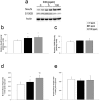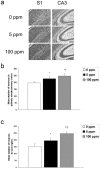Neurodevelopmental consequences of sub-clinical carbon monoxide exposure in newborn mice
- PMID: 22348142
- PMCID: PMC3277503
- DOI: 10.1371/journal.pone.0032029
Neurodevelopmental consequences of sub-clinical carbon monoxide exposure in newborn mice
Abstract
Carbon monoxide (CO) exposure at high concentrations results in overt neurotoxicity. Exposure to low CO concentrations occurs commonly yet is usually sub-clinical. Infants are uniquely vulnerable to a variety of toxins, however, the effects of postnatal sub-clinical CO exposure on the developing brain are unknown. Apoptosis occurs normally within the brain during development and is critical for synaptogenesis. Here we demonstrate that brief, postnatal sub-clinical CO exposure inhibits developmental neuroapoptosis resulting in impaired learning, memory, and social behavior. Three hour exposure to 5 ppm or 100 ppm CO impaired cytochrome c release, caspase-3 activation, and apoptosis in neocortex and hippocampus of 10 day old CD-1 mice. CO increased NeuN protein, neuronal numbers, and resulted in megalencephaly. CO-exposed mice demonstrated impaired memory and learning and reduced socialization following exposure. Thus, CO-mediated inhibition of neuroapoptosis might represent an important etiology of acquired neurocognitive impairment and behavioral disorders in children.
Conflict of interest statement
Figures










Similar articles
-
Carbon monoxide and anesthesia-induced neurotoxicity.Neurotoxicol Teratol. 2017 Mar-Apr;60:50-58. doi: 10.1016/j.ntt.2016.09.002. Epub 2016 Sep 9. Neurotoxicol Teratol. 2017. PMID: 27616667 Free PMC article. Review.
-
Subclinical carbon monoxide limits apoptosis in the developing brain after isoflurane exposure.Anesth Analg. 2014 Jun;118(6):1284-92. doi: 10.1213/ANE.0000000000000030. Anesth Analg. 2014. PMID: 24413549 Free PMC article.
-
Carbon monoxide incompletely prevents isoflurane-induced defects in murine neurodevelopment.Neurotoxicol Teratol. 2017 May;61:92-103. doi: 10.1016/j.ntt.2017.01.004. Epub 2017 Jan 26. Neurotoxicol Teratol. 2017. PMID: 28131877 Free PMC article.
-
Development of the Adverse Outcome Pathway (AOP): Chronic binding of antagonist to N-methyl-d-aspartate receptors (NMDARs) during brain development induces impairment of learning and memory abilities of children.Toxicol Appl Pharmacol. 2018 Sep 1;354:153-175. doi: 10.1016/j.taap.2018.02.024. Epub 2018 Mar 7. Toxicol Appl Pharmacol. 2018. PMID: 29524501 Free PMC article.
-
Carbon monoxide pollution and neurodevelopment: A public health concern.Neurotoxicol Teratol. 2015 May-Jun;49:31-40. doi: 10.1016/j.ntt.2015.03.001. Epub 2015 Mar 13. Neurotoxicol Teratol. 2015. PMID: 25772154 Free PMC article. Review.
Cited by
-
Carbon monoxide and anesthesia-induced neurotoxicity.Neurotoxicol Teratol. 2017 Mar-Apr;60:50-58. doi: 10.1016/j.ntt.2016.09.002. Epub 2016 Sep 9. Neurotoxicol Teratol. 2017. PMID: 27616667 Free PMC article. Review.
-
Critical Role of Nrf2 in Experimental Ischemic Stroke.Front Pharmacol. 2019 Mar 5;10:153. doi: 10.3389/fphar.2019.00153. eCollection 2019. Front Pharmacol. 2019. PMID: 30890934 Free PMC article. Review.
-
Subclinical carbon monoxide limits apoptosis in the developing brain after isoflurane exposure.Anesth Analg. 2014 Jun;118(6):1284-92. doi: 10.1213/ANE.0000000000000030. Anesth Analg. 2014. PMID: 24413549 Free PMC article.
-
Nicotinic cholinergic system alterations and nitrous oxide exposure in a mouse model: a hypothesis for the pathobiology of autism spectrum disorder.Psychopharmacology (Berl). 2017 Jan;234(2):317-318. doi: 10.1007/s00213-016-4457-9. Epub 2016 Oct 11. Psychopharmacology (Berl). 2017. PMID: 27730271 No abstract available.
-
Anesthesia-Related Carbon Monoxide Exposure: Toxicity and Potential Therapy.Anesth Analg. 2016 Sep;123(3):670-81. doi: 10.1213/ANE.0000000000001461. Anesth Analg. 2016. PMID: 27537758 Free PMC article. Review.
References
-
- Kao LW, Nañagas KA. Carbon monoxide poisoning. Emerg Med Clin North Am. 2004;22:985–1018. - PubMed
-
- Smithline HA, Ward KR, Chiulli DA, Blake HC, Rivers EP. Whole body oxygen consumption and critical oxygen delivery in response to prolonged and severe carbon monoxide poisoning. Resuscitation. 2003;56:97–104. - PubMed
-
- Hauck H, Neuberger M. Carbon monoxide uptake and the resulting carboxyhemoglobin in man. Eur J Appl Physiol Occup Physiol. 1984;53:186–90. - PubMed
-
- Gorman D, Drewry A, Huang YL, Sames C. The clinical toxicology of carbon monoxide. Toxicology. 2003;187:25–38. - PubMed
-
- Kao LW, Nanagas KA. Carbon monoxide poisoning. Med Clin North Am. 2005;89:1161–1194. - PubMed
Publication types
MeSH terms
Substances
Grants and funding
LinkOut - more resources
Full Text Sources
Medical
Research Materials

